Inspection hatches for tiles: an overview of the best designs and options for their arrangement
A lot of plumbing fixtures are installed in the bathrooms, each of which is connected to water supply and sewage systems. Siphons, taps, counters, hoses and pipes can spoil any interior, so many owners of the premises try to hide them.
A great option for camouflage is the revision hatch for tiles. The main thing here is to choose a suitable design and mount it correctly. Let's figure out what to look for when choosing a revision hatch and what rules should be followed so that the installed design lasts a long time without complaints about its functionality.
The content of the article:
What are the functions of revision hatches?
To mask electrical and piping, as well as the space under the bathroom, special boxes are used, screens and other similar designs.
All of them perfectly close unaesthetic nodes, however, the need for access to communications remains. Revision niches serve for this.
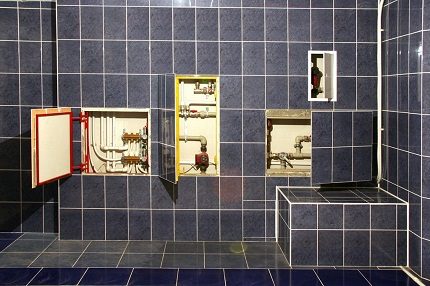
Some models of hatches for revision niches were originally designed so that they could be pasted over with the same coatings that the walls were decorated with: wallpaper, tile or panels.
Such structures do not stand out against the background of the walls, so they are called invisible.
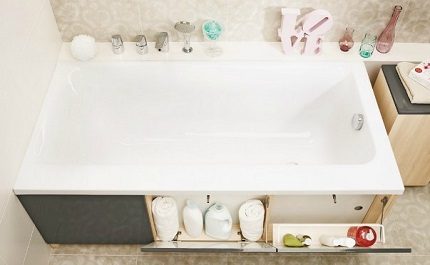
Sometimes niches in the walls serve to store a stock of hygiene products, washcloths, towels and other necessary accessories. They serve as lockers, but do not occupy space in the bathroom.
Such storage niches are also closed with revision hatches for tiles, and they do not attract too much attention.
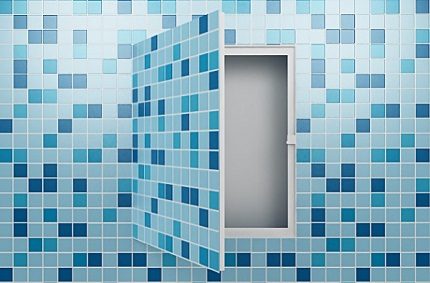
Thanks to invisible hatches, you can give free rein to designer imagination and not worry that pipes or wires will hopelessly ruin the interior. They can be hidden and, if necessary, easy to access. The main thing is to periodically conduct technical inspections so that behind the beautiful facade leaks of pipelines or breakdowns of meters do not appear.
Design features of models
Hatches are mounted in different parts of the room - in ceilings, walls, floors. In many ways, the design of each particular model depends on the location of the proposed location. Two main parts are unchanged - the frame and the door, the rest of the elements can vary depending on operating conditions.
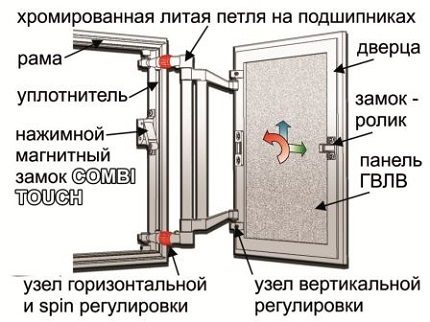
By the size of the technical niche they choose and model of a plumbing hatch. They are usually 20x20-120x120 cm. The frame is firmly installed in the opening, and then the doors are mounted. Most often they are mounted on hinge loops, which can be made of metal or plastic (depending on the material of the frame).
There are two main types of frames:
- Adjustable. The owner can independently choose the size of the frame, and the excess material is simply cut off with a suitable metal tool.
- Unregulated. The size of the hatch is set during its manufacture and is not subject to change.
There are also frameless models. They are mounted using magnetic plates, and the main elements are fixed to silicone sealant or other suitable adhesive compositions. Combined hatches are fixed using a frame and magnetic plates.
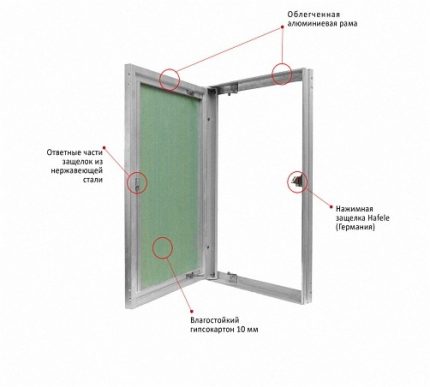
Inspection hatches are opened with suction cup handles. Push patterns are also common, which move away after pressing the door plane.
Depending on the location of the niche, you can find a hatch that opens left or right. There are models that shift in the vertical plane.
Revision hatches are convenient constructions that perfectly hide communication connection nodes without compromising freedom of access to them. They are easy to install and operate, reliable.
Structures do not need any special care: the surfaces of the doors can be washed with the same means that are used for walls.

In the process of using the inspection hatch, it is only necessary to monitor the state of the opening mechanism, lubricate it with engine oil in a timely manner and, as necessary, carry out minor repairs. Then the hatch will last as much as the wall decoration as a whole.
In some cases, you can even replace the tiles on the surface of the door if you carefully dismantle the old coating.
Opening mechanisms
Manufacturers install such door openers:
- swinging;
- push;
- folding;
- movable.
Each type of opening has its own advantages. When choosing, you should focus on ease of use.
It is hardly possible to come up with a more convenient opening mechanism than a swing mechanism. However, auditing is often needed where access is difficult due to equipment or furniture. Then folding and sliding models help out.
If there is a place at least on one side, it is better to choose a sliding mechanism. And for areas with difficult access, hinged structures with the ability to completely remove the door are more suitable.
The nuances of choosing the right hatch
When choosing a size, they are guided by the following parameters:
- Technical Niche Dimensions. The aperture can be slightly paved or expanded, but in general the hatch should correspond to a niche, otherwise access to the equipment will be difficult.
- Door dimensions. The ratio of the parameters of the support frame and the hatch itself may be different. It is necessary to clearly determine how much space is required for a detailed inspection and repair of communications.
- Tile size. Walling materials are usually bought in advance, and this makes it easier to choose a door. The tile should protrude 0.5-0.7 cm beyond the surface of the hatch (and it is better that the maximum protrusion is no more than 5 mm). It is also important that each tile is securely fixed: more than 60% of its area should be located on the hatch door.
For a spacious bathroom, you can choose a hinged hatch, and for a close one, a sliding or folding model is better.
If the opening of the revision niche is located on a plasterboard partition or false wall, then it is worth giving preference to a lightweight hinged structure on an aluminum frame.
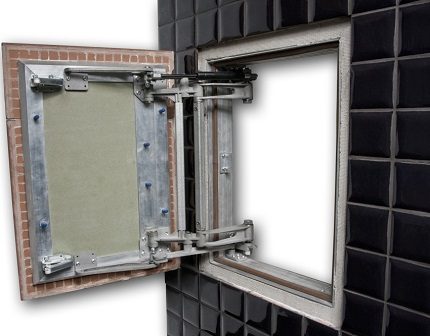
There are many manufacturers of inspection hatches whose products are worthy of attention.
The top three invariably include such brands:
- «Phantom". The main advantage of the hatches of this brand is powerful reliable hinges that withstand significant loads. Even heavily finished doors do not sag for many years.
- «Hammer". Hammer models feature high-strength frames. The secret of their quality lies in the assembly features: the manufacturer uses argon-arc welding.
- «Glory". These are hatches with wear-resistant fittings that can withstand almost any weight of the finish. Doors of models can be revetted with a ceramic tile and even a natural stone. They are not deformed.
The range of invisible hatches is extensive, and for each revision niche there is sure to be a suitable model. It is important not to save money and buy a design with a solid frame and good fittings.
Sometimes technical niches of large sizes are made, for example, if it is necessary to mask for a false-wall boiler, distributor, filter, meter, collector of cold and hot water or other equipment. Often, a large revision niche is required in the toilet or combined bathroom to service the sewer. If it is not possible to find a hatch of suitable sizes, then you can resort to others communication masking methods.
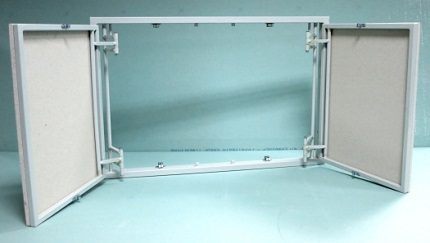
If the width of the opening exceeds 70 cm, you can choose a single-door hatch with a sturdy frame and a powerful opening mechanism, but it is better to stay on a two-door model. Most often, such hatches are equipped with push or swing opening mechanisms.
In the second case, the kit additionally includes suction cup handles.
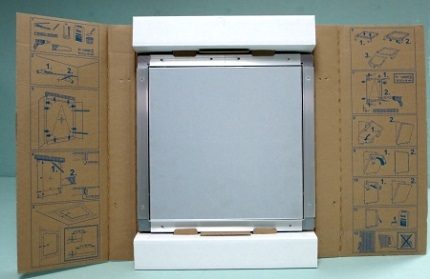
The maximum size of a standard two-door model is 120 x 160 cm, but if necessary, an even larger sunroof can be ordered. In this case, you should pre-determine the size of each of the doors.
They are calculated depending on the selected tile: it is necessary that when opening the doors do not cling to each other, but at the same time they are beautifully decorated with finishing material.
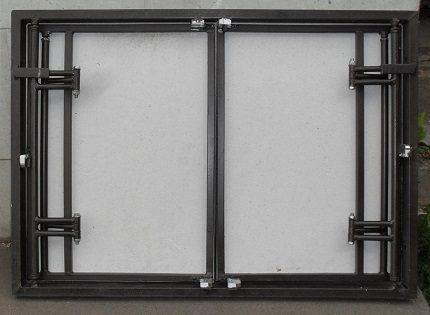
As for door materials, when choosing two-door inspection hatches, it is better to give preference to models made of moisture-resistant gypsum board. The option of drywall should not even be considered, because it will not withstand serious loads, quickly deforms and fails. Its only advantage is cheapness.
Tile hatch installation instructions
The installation of the inspection hatch can be divided into several stages:
- Opening preparation.
- Installation of a frame with doors.
- Finishing the outer surface of the doors.
- Finishing work.
Each of the stages provides for several types of work. To avoid difficulties, we offer useful installation tips with illustrations:
After installation, it remains only to make sure that the hatch is functioning normally, the seam is neat, and the tile does not cling to anything when opening the door. If everything is in order, the design is fully operational.
Conclusions and useful video on the topic
When buying and installing a revision hatch under a tile, many factors should be considered. In order not to get confused and successfully cope with the task, check out the helpful video on the topic.
The video is devoted to a variety of designs and mechanisms for opening hatches:
Correct size calculation is the most difficult task when choosing the right model. Listen to the recommendations of a specialist:
Any person who has learned to hold tools in his hands can handle the installation of the hatch. However, there are several points that should be given special attention:
The need for inspection hatches arises infrequently: preventive examinations are carried out once every few months. But it is these simple designs that help out in difficult situations, when you need to urgently eliminate leaks, clean the siphon or replace the counter.
Thanks to the invisible hatches, you can beautifully decorate the interior without focusing on the elements that provide its functionality.
Choose a revision hatch, but have not yet decided on your choice? Or do you already have experience using such designs and can you give valuable advice to our readers? Please leave comments on this material, ask questions on the topic in the block below.

 How to choose a dry closet for a summer residence: tips for choosing and an overview of the best models
How to choose a dry closet for a summer residence: tips for choosing and an overview of the best models  Sewer pipes for outdoor sewers: types and overview of the best brands
Sewer pipes for outdoor sewers: types and overview of the best brands 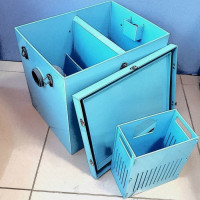 Grease trap for washing: operating principle, types of structures and features of their installation
Grease trap for washing: operating principle, types of structures and features of their installation  Sewerage device in a country house: arrangement schemes + installation instructions
Sewerage device in a country house: arrangement schemes + installation instructions  How to make a blind area around the house with your own hands: rules and methods for arranging the ebb system
How to make a blind area around the house with your own hands: rules and methods for arranging the ebb system  How much does it cost to connect gas to a private house: the price of organizing gas supply
How much does it cost to connect gas to a private house: the price of organizing gas supply  The best washing machines with dryer: model rating and customer tips
The best washing machines with dryer: model rating and customer tips  What is the color temperature of light and the nuances of choosing the temperature of the lamps to suit your needs
What is the color temperature of light and the nuances of choosing the temperature of the lamps to suit your needs  Replacement of a geyser in an apartment: replacement paperwork + basic norms and requirements
Replacement of a geyser in an apartment: replacement paperwork + basic norms and requirements
They made repairs to the bathrooms, faced with the need to make a hatch in the toilet and a box in the bathroom. The process was quite time-consuming. Yes, and the payment of the master is taken for the manufacture of such structures much more than for laying tiles. But it also gives convenience. Now the voids are covered, there is access to the counters, everything is civil, and any trifle can be stored.
Andrey, such a hatch or door is easy to do on your own. I installed because my husband was busy with other work.
In a hardware store I bought a plastic frame of the right size with a door, put it in the opening on building glue, and it could have been on cement. On top of the door glued tiles, which in size needed only to be trimmed beforehand. All work is done faster than going to the store.
It is very convenient when in this revision hatch there are shelves for storing cleaning chemicals, in our new apartment we plan to do just that. If you arrange a hatch of tiles, then I advise you to make a stock of this tile. The fact is that with us this hatch was made of one large hollow tile and was simply removed. And one day he somehow unsuccessfully fell and a piece of tile broke off. If there was a supply of tiles, it would be possible to replace it without problems.
Of course, such technological holes are very convenient both from the point of view of decorative elements, and an additional place is formed. It’s bad that in the houses of the old model (Soviet times) little thought was given to aesthetics, and they simply didn’t. That is why I really want a private house, where every square meter will be made in my opinion, and nothing else.
Sasha, in Khrushchev’s, such hatches can (and should) be installed on your own. Under the bath, behind the toilet in the toilet, where all the pipes go. And the view is better, and a mass of shelves is formed, for storage.